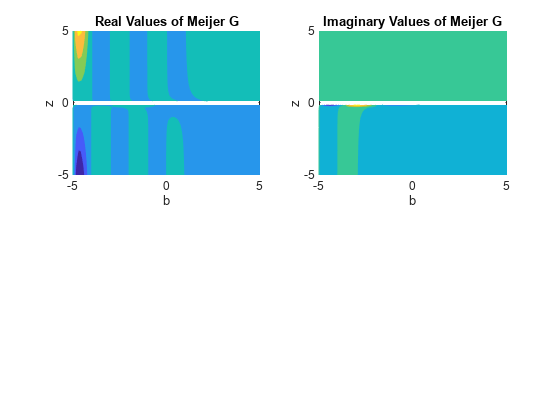meijerG
マイヤーの G 関数
説明
例
入力引数
詳細
アルゴリズム
ai ∊ (a1,…,an) および bj ∊ (b1,…,bm) のマイヤーの G 関数 meijerG([a1,…,an], [an + 1,…,ap], [b1,…,bm], [bm + 1,…,bq], z) について、パラメーターの差 ai − bj はいずれも正の整数にはなりません。
マイヤーの G 関数は、積分経路が次のいずれかである複素閉曲線積分を含みます。
閉曲線は - i ∞ から i ∞ へ、、j = 1, …, m のすべての極が経路の右側に、、k = 1, …, n のすべての極が経路の左側に位置するように進む。、|arg(z)| < c π である場合、積分は収束します。|arg(z)| = c π、c ≥ 0 である場合、p = q および ℜ(ψ) < - 1 のとき積分は完全に収束します。ここで、 です。p ≠ q のとき、閉曲線を選択し、閉曲線の i ∞ および - i ∞ 付近の点が を満たす実数部 σ をもつ場合、積分は収束します。
閉曲線は始点と終点が ∞ であるループで、負の方向に移動する 、j = 1, …, mのすべての極を囲むが、、k = 1, …, n のいずれの極も囲まない。q ≥ 1 で、かつ p < q または p = q かつ |z| < 1 である場合、積分は収束します。
閉曲線は始点と終点が - ∞ であるループで、正の方向に移動する 、k = 1, …, n のすべての極を囲むが、、j = 1, …, m のいずれの極も囲まない。p ≥ 1 で、かつ p > q または p = q かつ |z| > 1 である場合、積分は収束します。
積分は逆ラプラス変換または、より具体的には、メリン・バーンズ積分を表します。
与えられたパラメーターの集合について、マイヤーの G 関数の定義で選択された閉曲線は積分が収束する際の閉曲線と同一です。いくつかの閉曲線に対して積分が収束する場合、すべての閉曲線は同じ関数を導出します。
マイヤーの G 関数は、変数 z についての階数 max(p, q) の次の微分方程式を満たします。
p < q の場合、この微分方程式は z = 0 において確定特異点をもち、z = ∞ に不確定特異点をもちます。p = q の場合、点 z = 0 および z = ∞ は確定特異点であり、z = (−1)m + n - p に追加の確定特異点があります。
マイヤーの G 関数は、超幾何関数の解析接続を表します [1]。特定のパラメーターを選択した場合、超幾何関数を用いてマイヤーの G 関数を表現できます。たとえば、bh 項、h = 1, …, m のうちどの 2 項も整数または 0 で異なり、かつすべての極が単純極の場合、次のようになります。
ここで、p < q または p = q かつ |z| < 1 です。Ah は次を表します。
Bh は次を表します。
パラメーターの異なるマイヤーの G 関数で、同じ関数を表現できます。
マイヤーの G 関数はパラメーターについて対称です。次のベクトル配列それぞれの内部で順序を変更しても、マイヤーの G 関数の結果は変わりません。[a1, …, an]、[an + 1, …, ap]、[b1, …, bm]、[bm + 1, …, bq]
z が負の実数ではなくかつ z ≠ 0 の場合、関数は次の恒等式を満たします。
0 < n < p かつ r = a1 - ap が整数の場合、関数は次の恒等式を満たします。
0 < m < q かつ r = b1 - bq が整数の場合、関数は次の恒等式を満たします。
これらの規則に従い、関数 meijerG の呼び出しは入力パラメーターを変更して meijerG を返すことができます。
参照
[1] Luke, Y. L., The Special Functions and Their Approximations. Vol. 1. New York: Academic Press, 1969.
[2] Prudnikov, A. P., Yu. A. Brychkov, and O. I. Marichev, Integrals and Series. Vol 3: More Special Functions. Gordon and Breach, 1990.
[3] Abramowitz, M., I. A. Stegun, Handbook of Mathematical Functions. 9th printing. New York: Dover Publications, 1970.
バージョン履歴
R2017b で導入
